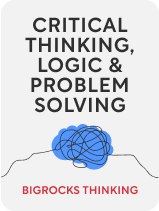

This article is an excerpt from the Shortform book guide to "Critical Thinking, Logic & Problem Solving" by Bigrocks Thinking. Shortform has the world's best summaries and analyses of books you should be reading.
Like this article? Sign up for a free trial here.
What is a logic tree? How can it help you solve problems? How do you create one?
Critical Thinking, Logic & Problem Solving by Bigrocks Thinking shows you how to apply critical thinking to solve problems and make decisions more effectively. The authors recommend using a logic tree to find solutions to your problems and answers to your questions.
Continue reading to see a logic tree example and learn the steps to create one for yourself.
Logic Tree Example & Steps
Once you understand the problem you’re facing, you can begin forming solutions by first identifying potential solutions. You can use tools such as logic trees to help you identify solutions and make decisions.
What is a logic tree? It’s a tool that allows you to visually lay out potential solutions or options so you can consider them more easily. Check out the logic tree example below, where the problem is what math class to take as an incoming college freshman, and the possible solutions are calculus, statistics, and trigonometry.
Create Your Own Logic Tree
You can format the tree in whatever way works best for you, but these are the basic steps:
- Write down your problem or question.
- Add branches that show your options and further branches that provide the details of those options, such as benefits, consequences, or other factors to consider.
(Shortform note: Sometimes you may encounter problems that you’ve had before but find that the old solutions no longer work to fix them. Tools like logic trees can be especially helpful in these cases, as the visual aid can make it easier to understand and remember the different solutions and their characteristics. The human brain is faster at visual processing than verbal processing, so these tools facilitate faster decision-making and easier communication within groups. Other visual aids for identifying solutions include mind maps: For this, you would begin with a central idea in the middle of the page and then add thoughts as they occur to you, using lines to link them together or back to the central point.)

———End of Preview———
Like what you just read? Read the rest of the world's best book summary and analysis of Bigrocks Thinking's "Critical Thinking, Logic & Problem Solving" at Shortform.
Here's what you'll find in our full Critical Thinking, Logic & Problem Solving summary:
- A step-by-step guide for improving critical thinking and problem-solving skills
- Tips for conducting better research and finding reliable resources
- How to improve your communication and storytelling skills






